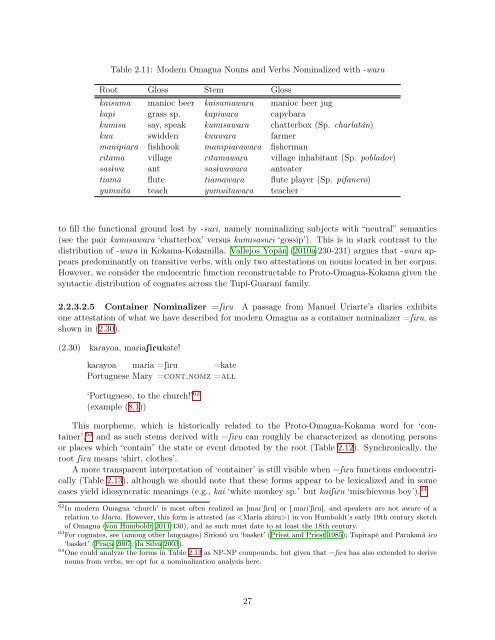draft manuscript - Linguistics - University of California, Berkeley
draft manuscript - Linguistics - University of California, Berkeley
draft manuscript - Linguistics - University of California, Berkeley
Create successful ePaper yourself
Turn your PDF publications into a flip-book with our unique Google optimized e-Paper software.
Table 2.11: Modern Omagua Nouns and Verbs Nominalized with -waRa<br />
Root Gloss Stem Gloss<br />
kaisuma manioc beer kaisumawaRa manioc beer jug<br />
kapi grass sp. kapiwaRa capybara<br />
kumIsa say, speak kumIsawaRa chatterbox (Sp. charlatán)<br />
kuu swidden kuuwaRa farmer<br />
manipiaRa fishhook manipiaRawaRa fisherman<br />
Ritama village RitamawaRa village inhabitant (Sp. poblador)<br />
sas1wa ant sas1wawaRa anteater<br />
tiama flute tiamawaRa flute player (Sp. pifanero)<br />
yumuita teach yumuitawaRa teacher<br />
to fill the functional ground lost by -suRi, namely nominalizing subjects with “neutral” semantics<br />
(see the pair kumIsawaRa ‘chatterbox’ versus kumIsasuRi ‘gossip’). This is in stark contrast to the<br />
distribution <strong>of</strong> -waRa in Kokama-Kokamilla. Vallejos Yopán (2010a:230-231) argues that -waRa appears<br />
predominantly on transitive verbs, with only two attestations on nouns located in her corpus.<br />
However, we consider the endocentric function reconstructable to Proto-Omagua-Kokama given the<br />
syntactic distribution <strong>of</strong> cognates across the Tupí-Guaraní family.<br />
2.2.3.2.5 Container Nominalizer =SiRu A passage from Manuel Uriarte’s diaries exhibits<br />
one attestation <strong>of</strong> what we have described for modern Omagua as a container nominalizer =SiRu, as<br />
shown in (2.30).<br />
(2.30) kaRayoa, maRiaSiRukate!<br />
kaRayoa maRia =SiRu =kate<br />
Portuguese Mary =cont.nomz =all<br />
‘Portuguese, to the church!’ 62<br />
(example (8.1))<br />
This morpheme, which is historically related to the Proto-Omagua-Kokama word for ‘container’,<br />
63 and as such stems derived with =SiRu can roughly be characterized as denoting persons<br />
or places which “contain” the state or event denoted by the root (Table 2.12). Synchronically, the<br />
root SiRu means ‘shirt, clothes’.<br />
A more transparent interpretation <strong>of</strong> ‘container’ is still visible when =SiRu functions endocentrically<br />
(Table 2.13), although we should note that these forms appear to be lexicalized and in some<br />
cases yield idiosyncratic meanings (e.g., kai ‘white monkey sp.’ but kaiSiRu ‘mischievous boy’). 64<br />
62 In modern Omagua ‘church’ is most <strong>of</strong>ten realized as [maR"SiRu] or [maRi"SiRu], and speakers are not aware <strong>of</strong> a<br />
relation to Maria. However, this form is attested (as ) in von Humboldt’s early 19th century sketch<br />
<strong>of</strong> Omagua (von Humboldt 2011:430), and as such must date to at least the 18th century.<br />
63 For cognates, see (among other languages) Sirionó iRu ‘basket’ (Priest and Priest 1985); Tapirapé and Parakanã 1Ro<br />
‘basket’ (Praça 2007; da Silva 2003).<br />
64 One could analyze the forms in Table 2.13 as NP-NP compounds, but given that =SiRu has also extended to derive<br />
nouns from verbs, we opt for a nominalization analysis here.<br />
27
















